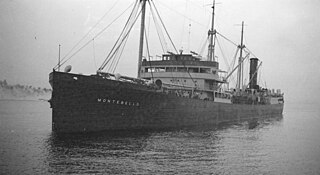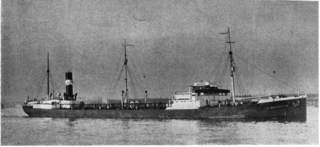Related Research Articles

USCGC Mesquite (WAGL/WLB-305) was the lead ship in the Mesquite class of seagoing buoy tenders operated by the United States Coast Guard. She served in the Pacific during World War II, and spent the rest of her Coast Guard career in the Great Lakes. She ran aground and was wrecked in December 1989 off the Keweenaw Peninsula in Lake Superior. She was scuttled nearby as a recreational diving attraction.

USS Alameda, was a United States Navy tanker in commission from 1919 to 1922. She was built as the civilian tanker SS Alameda, but transferred to the U.S. Navy after completion in 1919. She was sold for commercial service and operated under the names SS Olean and SS Sweep before she was transferred to the Navy again in World War II as USS Silver Cloud (IX-143).

The T2 tanker, or T2, was a class of oil tanker constructed and produced in large quantities in the United States during World War II. Only the T3 tankers were larger "navy oilers" of the period. Some 533 T2s were built between 1940 and the end of 1945. They were used to transport fuel oil, diesel fuel, gasoline and sometimes black oil-crude oil. Post war many T2s remained in use; like other hastily built World War II ships pressed into peacetime service, there were safety concerns. As was found during the war, the United States Coast Guard Marine Board of Investigation in 1952 stated that in cold weather the ships were prone to metal fatigue cracking, so were "belted" with steel straps. This occurred after two T2s, Pendleton and Fort Mercer, split in two off Cape Cod within hours of each other. Pendleton's sinking is memorialized in The Finest Hours. Engineering inquiries into the problem suggested the cause was poor welding techniques. It was found the steel was not well suited for the new wartime welding construction. The high sulfur content made the steel brittle and prone to metal fatigue at lower temperatures.

Hammac was a steam tank ship built in 1920–1921 by Bethlehem Shipbuilding Corporation of Alameda for the United States Shipping Board as part of the wartime shipbuilding program of the Emergency Fleet Corporation (EFC) to restore the nation's Merchant Marine. Early in 1923 the vessel together with two other tankers was sold to General Petroleum Corporation and renamed Emidio. The tanker spent the vast majority of her career carrying oil along the West Coast of the United States as well as between West and East coast. In December 1941 she was shelled and damaged by the Japanese submarine I-17 and eventually wrecked with a loss of five crewmen.

SS Marine Sulphur Queen, formally Esso New Haven, was T2 tanker converted to carry molten sulphur. It is notable for its disappearance in 1963 near the southern coast of Florida, taking the lives of 39 crewmen.
SS V.A. Fogg was a modified T2 tanker built in 1943, as SS Four Lakes. After service in World War II, she was eventually sold into private ownership. She was renamed V.A. Fogg in 1971, shortly before she exploded and sank off Freeport, Texas.

Montebello was a steam oil tanker built in 1920–1921 by the Southwestern Shipbuilding Co. of San Pedro for Union Oil Company with the intention of carrying oil and petroleum products along the West Coast of the United States and Canada as well as between the United States and Chile. In December 1941 the tanker was sunk on one of her regular trips by the Japanese submarine I-21.
Sylvan Arrow was a steam tanker built in 1917–1918 by New York Shipbuilding Co. of Camden for Standard Oil Company, with intention of transporting oil and petroleum products between United States and ports in the Far East. The ship was briefly requisitioned by the US Government during World War I but returned to commercial service in early 1919.
MV C.O. Stillman was an oil tanker that was built by a German shipyard in 1928 for a Canadian-based shipping company. A Panamanian subsidiary of Esso bought her at the end of 1936 and she was sunk by the German submarine U-68 in the Caribbean on June 4, 1942 about 41 nautical miles (76 km) southwest of Isla de Mona, Puerto Rico.

SS Pendleton was a Type T2-SE-A1 tanker built in 1944 in Portland, Oregon, United States, for the War Shipping Administration. She was sold in 1948 to National Bulk Carriers, serving until February 1952 when she broke in two in a storm. The T2 tanker ships were prone to splitting in two in cold weather. The ship's sinking and crew rescue is the topic of the 2009 book The Finest Hours: The True Story Behind the US Coast Guard's Most Daring Rescue, by Michael J. Tougias. Tougias' book inspired the 2016 Disney-produced film The Finest Hours with Chris Pine, which focuses on the Pendleton rescue.
MV S.E. Graham was an oil tanker that was built in 1943 and operated by the Graham Company until her loss in 1958. She was 250 feet (76 m) in length and measured 1,591 gross tons.
In June 1966, the British oil tanker MV Alva Cape caught fire twice in New York Harbor, first in a collision with tanker SS Texaco Massachusetts, and next while unloading cargo, and was subsequently scuttled offshore. Thirty-three people were killed in the collision, the resulting spill of its cargo of naphtha and major fire that ensued. Four more were killed about two weeks later while the emptied tanks were being inerted with carbon dioxide in a misguided attempt to make the damaged vessel safe for transport.
SSGrand Zenith was an oil tanker that sank sometime after December 30, 1976 with the loss of all hands.
MV Hawaiian Patriot was an oil tanker that sank in the Pacific Ocean in 1977 with the loss of her cargo and one crewmember.
The SS Puerto Rican, was an American-flagged tanker disabled by an explosion on October 31, 1984. The 20,295 GRT, 632 ft (192.6 m), tanker was owned by Bankers Trust Company and operated by Keystone Shipping Co. of Philadelphia which burned in an explosion with the stern section sinking just hours after leaving San Francisco bound for New Orleans with a cargo of 91,984 barrels of lubricating oil and additives. In addition to the cargo the ship was fueled with 8,500 barrels of Heavy Fuel Oil before departure.
The Sanchioil tanker collision occurred on 6 January 2018 when the Panamanian-flagged, Iranian-owned tanker Sanchi, with a full natural-gas condensate cargo of 136,000 tonnes, sailing from Iran to South Korea, collided with the Hong Kong-flagged cargo ship CF Crystal 160 nautical miles (300 km) off Shanghai, China. Sanchi caught fire shortly after the collision; after burning and drifting for over a week, it sank on 14 January.

Samuel Q. Brown was a steam tanker built in 1920–1921 by Merchant Shipbuilding Corporation of Chester for Tide Water Oil Co., a subsidiary of Standard Oil, with intention of operating between New York and the oil-producing ports of the southern United States and Mexico.

China Arrow was a steam tanker built in 1920 by Bethlehem Shipbuilding Corporation of Quincy for Standard Oil Co., with intention of transporting oil and petroleum products between United States and the Far East. During the first part of her career the tanker was used to carry oil and gasoline between United States and Asia, later becoming a coastal tanker serving the East Coast of the United States. The ship was torpedoed and sunk in February 1942 on one of her regular trips by German submarine U-103.

USCGC Ironwood (WAGL-297/WLB-297) was a Mesquite-class sea-going buoy tender operated by the United States Coast Guard. She served in World War II, the Korean War, and the Vietnam War as well as a variety of domestic missions. She currently serves as a seamanship training vessel for Job Corps.

J. A. Moffett Jr. was an oil tanker built in 1920–1921 by the Federal Shipbuilding Company of Kearney for the Standard Oil Company of New Jersey with the purpose of carrying oil and petroleum products. Originally built as a steamship, the vessel had her engines changed in 1927 converting her into a motor vessel. She was torpedoed in 1942, killing the captain, before being abandoned, towed and sold for scrap.
References
- 1 2 3 4 "3 Missing in Breakup of Tanker". The New York Times. January 19, 1977. Retrieved April 5, 2017.
- 1 2 3 "Tanker Breaks Up in the Pacific". The New York Times. January 18, 1977. Retrieved April 5, 2017.
- ↑ "Regulations to Implement the Results of the International Conference on Tanker Safety and Pollution Prevention". United States Coast Guard. February 1979. Retrieved April 5, 2017.